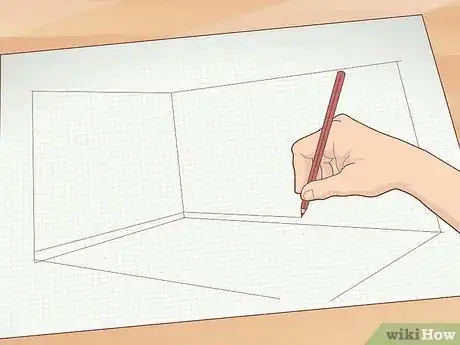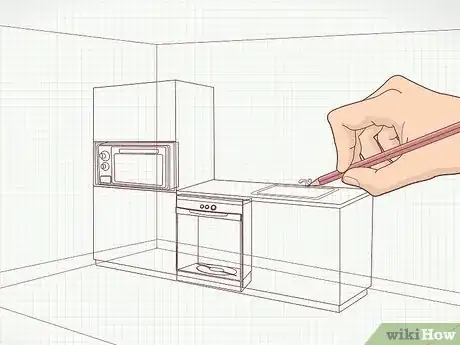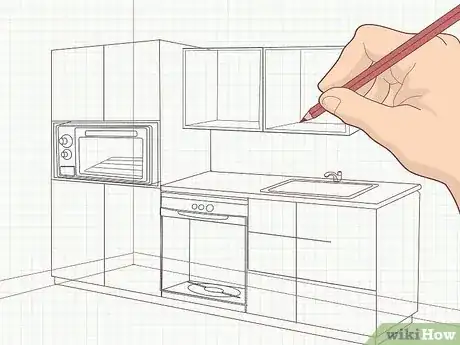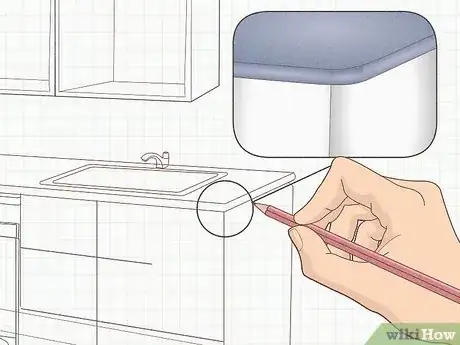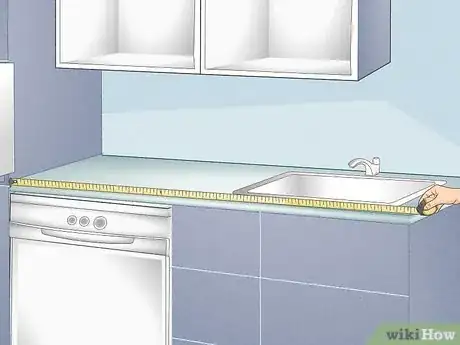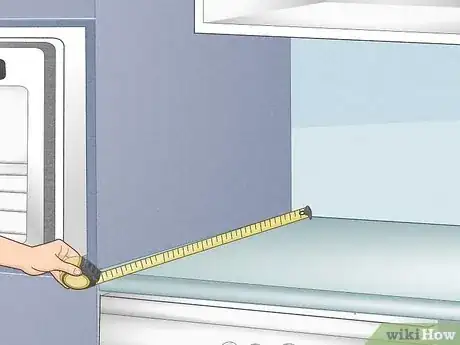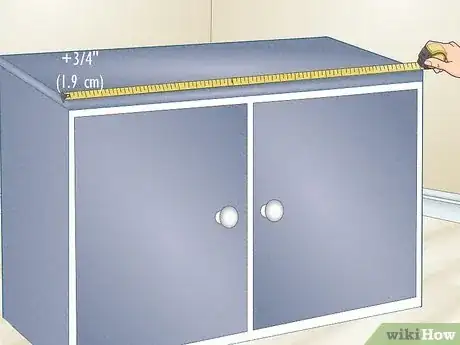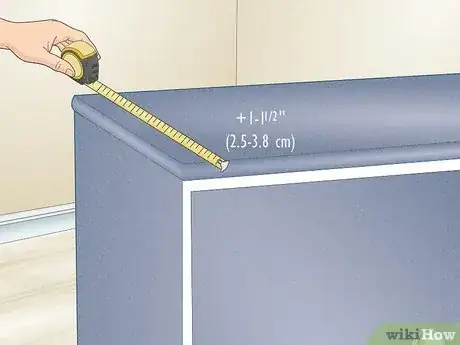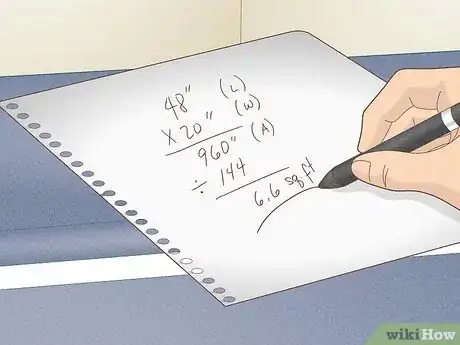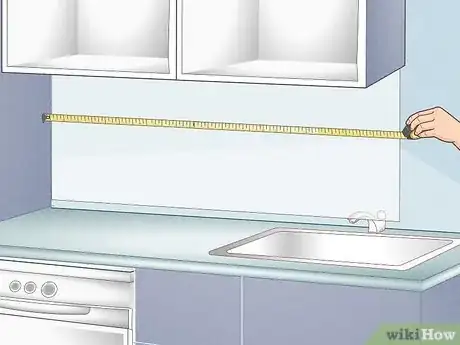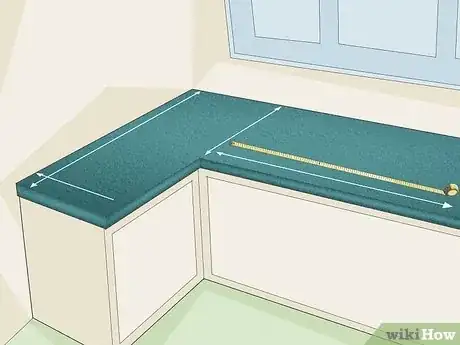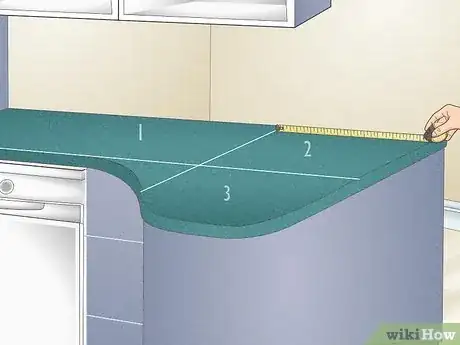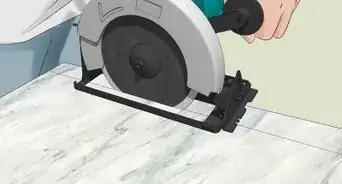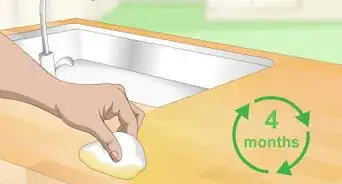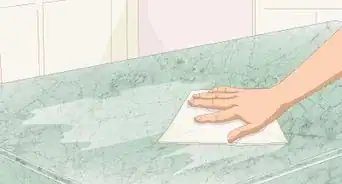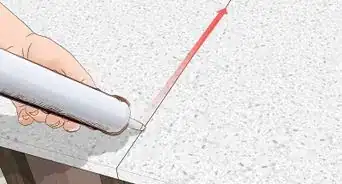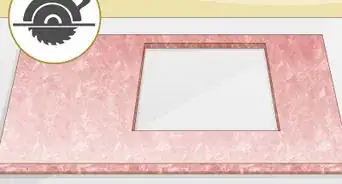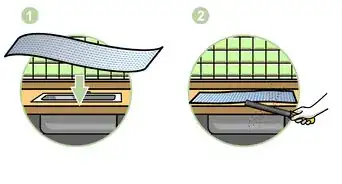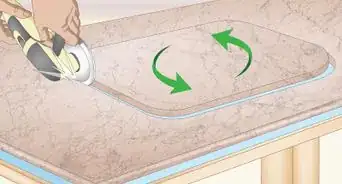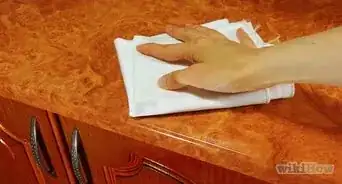This article was co-authored by Mitchell Newman. Mitchell Newman is the Principal at Habitar Design and its sister company Stratagem Construction in Chicago, Illinois. He has 20 years of experience in construction, interior design and real estate development.
This article has been viewed 108,443 times.
Installing new countertops is a great way to revamp your kitchen or bathroom, but first you need to measure the square footage of your old countertops. Fortunately, finding the square footage of countertops is super easy—you just need a tape measure, a calculator, and something to write with. This article will walk you through the whole process step-by-step, including how to make a convenient diagram of your countertops for contractors (if you don't need a diagram, skip down to method 2).
Things You Should Know
- A full diagram of your kitchen layout will help you (or your installers) understand precisely where the countertops need to go.
- When you measure countertops, add 3⁄4 inch (1.9 cm) to the lengths for the overhang and round to the nearest 1⁄8 inch (0.32 cm).
- Treat L-shaped countertops as a single piece and don’t include the sink in your calculations.
- Account for the depth of your backsplash in your measurements if you need a gap and multiply the length (in inches) by 4 to find the square footage of the backsplash tiles.
Steps
Drawing a Rough Diagram of Your Layout
-
1Sketch the room. Prior to measuring your countertops, create a rough diagram of your kitchen or bathroom. The drawing provides a visual to potential contractors and serves as a convenient place to record your measurements. It does not need to be to scale.[1] Retrieve a piece of graph paper and a pencil. Draw a model of your space—sketch the walls and mark the doorways.
-
2Sketch the appliances, sinks, and faucets. The location of appliances, sinks, and fixtures must be added to your diagram.
- If you are you keeping your current appliances and fixtures, roughly draw your existing appliances, sinks, and faucets on the diagram.
- If you are you replacing your existing appliances or altering the layout of your space, sketch the location of your new appliances, sinks, and or faucets on the diagram.
- It is also helpful to note the type of sink, refrigerator, stove, and range found in your space.
Advertisement -
3Draw the layout of your cabinets. Sketch the layout of your cabinets on your diagram. Again, the dimensions do not need to be precise or to scale.
- If you intend to keep your existing cabinetry, draw the current layout of your cabinets on your diagram.
- If you intend to alter the layout of your space and or replace your cabinets, sketch the new cabinetry layout or use an online program to design your space.
-
4Note edge types or sweeps. Countertops are highly customizable. The unique touches you select may alter your quote and therefore should be noted in your diagram.
- Choose an edge type for your countertops: 3⁄8 inch (1.0 cm) rounded solid surface, eased stone, bevel stone, ogee stone, or bevel solid surface.[2]
- Mark any sweeps, or rounded overhangs.
Measuring Your Existing Countertops
-
1Measure the length of your existing countertops in inches. To measure the length of one section of countertops, run a measuring tape flush along the back edge of the section from one end to the other end. The beginning and end of a section is marked by a wall, edge of a cabinet, or an appliance. Add 3⁄4 inch (1.9 cm) to the length, and round the measurement to the nearest 1⁄8 inch (0.32 cm). Record this measurement on your diagram or a separate sheet of paper. Repeat this process until you have measured the length of each section of your countertops.
- Do not stop measuring when you reach a sink, but continue to measure beyond the sink until you reach the end of a cabinet, appliance, or a wall.[3]
- If you have an L-shaped countertop, measure the long side first, followed by the short side from the back edge. Add the total measurements together to treat it like one countertop.
-
2Measure the width of your existing countertops in inches. Use a measuring tape to measure the width of each section of countertop. Run the measuring tape from the back of the countertop to its finished front edge. Round the measurement to the nearest 1⁄8 inch (0.32 cm) and record this measurement on your diagram or a separate sheet of paper. Repeat this process until you have measured the width of each section of countertop.
- If you have a backsplash, account for its dimensions in your final measurement.
-
3Calculate the square footage. In order to receive an estimate from a contractor for your new countertops, you need to provide an approximate calculation of your existing countertops’ square footage.
- Calculate the area (or square inches) of each section by multiplying the length times the width of each section (Length x Width = Area).
- Calculate the total square inches by adding together the areas of each section.
- Calculate the square footage by dividing the total square inches by 144 (Total Square Inches ➗ 144 = Total Square Footage).[4]
Measuring New Cabinets for Countertops
-
1Measure the length of your new cabinets in inches. When measuring the length of one section of cabinets, run a measuring tape flush along the back edge of the section from one end to the other end. Add 3⁄4 inch (1.9 cm) to the measurement, and round the measurement to the nearest 1⁄8 inch (0.32 cm). Record this measurement on your diagram or a separate sheet of paper. Repeat this process until you have measured the length of each section of your new cabinetry.
-
2Measure the width of your new cabinets and add 1–1 1⁄2 in (2.5–3.8 cm). When measuring the depth of your new cabinets, you must account for the overhang of the countertop. Run the measuring tape from the back of the cabinet to the front top edge of the cabinet. To account for the countertops’ overhang, add 1–1 1⁄2 in (2.5–3.8 cm) to the measurement. Record this revised number on your diagram or a separate sheet of paper. Repeat this process until you have measured the width of each section of cabinets.
- To account for the overhang of an island, you must add 3 inches to the length and 3 inches to the width.
-
3Calculate the square footage. To receive an estimate from a contractor for the cost of your new countertops, you need to provide an approximate calculation of the countertops’ square footage.
- Calculate the area (or square inches) of each section by multiplying the length times the width of each section (Length x Width = Area).
- Calculate the total square inches by adding together the areas of each section.
- Calculate the square footage by dividing the total square inches by 144 (Total Square Inches ➗ 144 = Total Square Footage).[5]
Measuring a Backsplash and Countertops with Angles
-
1Measure the length of the backsplash and calculate the square footage. If you have or are planning to add a backsplash, account for its dimensions in your final measurement.
- Measure the length of the backsplash for each section of countertop.
- Add the lengths together.
- Multiply the total length of the backsplash by 4 inches (the height of the backsplash).
- Divide the product by 140 to calculate the total square footage of your backsplash.
- Add this number to the total square footage of your countertops.
-
2Measure an L-shaped counter. Often countertops run along two perpendicular walls, forming an L-shape.
- When measuring this layout, you must first verify that your corner is a 90° angle. Measure and mark 3 feet from the corner along one wall. Measure and mark 4 feet from the corner along the other wall. Measure the diagonal distance between the two points. If the distance is 5 feet, then your corner is square.
- Divide the counter into two sections.
- To determine the length of section A, measure from one end of the counter to the wall. To determine the width of section A, measure from the front edge of the counter to the wall.
- To determine the length of section B, measure from the opposite end of the counter to the wall. Subtract the width of section A to get the length of section B. To determine the width of section B, measure from the front edge of the counter to the wall.
- Calculate the area (or square inches) of each section by multiplying the length times the width of each section (Length x Width = Area).
- Calculate the total square inches by adding together the areas of each section.
- Calculate the square footage by dividing the total square inches by 144 (Total Square Inches ➗ 144 = Total Square Footage).[6]
-
3Measure irregular countertops. If your countertops are irregularly shaped, divide the countertop into square sections. These sections may overlap and or include negative or blank space. Once you have sectioned off the countertop into squares, measure the length and width of each section. For each section, multiply the length by the width.
- Calculate the area (or square inches) of each section by multiplying the length times the width of each section (Length x Width = Area).
- Calculate the total square inches by adding together the areas of each section.
- Calculate the square footage by dividing the total square inches by 144 (Total Square Inches ➗ 144 = Total Square Footage).[7]
Expert Q&A
-
QuestionAre porous or non-porous countertops better?
 Mitchell NewmanMitchell Newman is the Principal at Habitar Design and its sister company Stratagem Construction in Chicago, Illinois. He has 20 years of experience in construction, interior design and real estate development.
Mitchell NewmanMitchell Newman is the Principal at Habitar Design and its sister company Stratagem Construction in Chicago, Illinois. He has 20 years of experience in construction, interior design and real estate development.
Construction Professional Non-porous is always better if you're worried about stains. Porous stone absorbs whatever spills into it, so it can be a lot harder to get stains out. So, things like limestone and marble are going to show something like a red wine stain because they're super porous.
Non-porous is always better if you're worried about stains. Porous stone absorbs whatever spills into it, so it can be a lot harder to get stains out. So, things like limestone and marble are going to show something like a red wine stain because they're super porous. -
QuestionDo you need to seal countertops?
 Mitchell NewmanMitchell Newman is the Principal at Habitar Design and its sister company Stratagem Construction in Chicago, Illinois. He has 20 years of experience in construction, interior design and real estate development.
Mitchell NewmanMitchell Newman is the Principal at Habitar Design and its sister company Stratagem Construction in Chicago, Illinois. He has 20 years of experience in construction, interior design and real estate development.
Construction Professional It depends on the material, but usually, yes. Something like marble absolutely needs to be sealed. Occasionally, manufacturers will ship counters out pre-sealed, but you do need to reseal them periodically.
It depends on the material, but usually, yes. Something like marble absolutely needs to be sealed. Occasionally, manufacturers will ship counters out pre-sealed, but you do need to reseal them periodically. -
QuestionIs quartz good for countertops?
 Mitchell NewmanMitchell Newman is the Principal at Habitar Design and its sister company Stratagem Construction in Chicago, Illinois. He has 20 years of experience in construction, interior design and real estate development.
Mitchell NewmanMitchell Newman is the Principal at Habitar Design and its sister company Stratagem Construction in Chicago, Illinois. He has 20 years of experience in construction, interior design and real estate development.
Construction Professional Quartz is really one of the best options out there. It's not porous, it's very difficult to stain it, and it comes in a variety of styles and looks. Quartz is also super durable, which is something you really want in a countertop.
Quartz is really one of the best options out there. It's not porous, it's very difficult to stain it, and it comes in a variety of styles and looks. Quartz is also super durable, which is something you really want in a countertop.
Warnings
- Some stone countertops, such as granite, are cut from large slabs. The layout of your countertops may require multiple slabs. Therefore, the amount of material you need to purchase may exceed the total square footage required for the project.⧼thumbs_response⧽
Things You'll Need
- Measuring tape
- Graph Paper
- Pencil
- Calculator
References
- ↑ http://www.expresscountertops.com/how-to-measure-countertops-md-va-dc
- ↑ http://www.homedepot.com/hdus/en_US/DTCCOM/HomePage/Categories/Kitchen/Countertops/Docs/Countertop-Project-Estimation-Sheet.pdf
- ↑ http://www.expresscountertops.com/how-to-measure-countertops-md-va-dc
- ↑ http://www.homedepot.com/hdus/en_US/DTCCOM/HomePage/Categories/Kitchen/Countertops/Docs/Countertop-Project-Estimation-Sheet.pdf
- ↑ http://www.homedepot.com/hdus/en_US/DTCCOM/HomePage/Categories/Kitchen/Countertops/Docs/Countertop-Project-Estimation-Sheet.pdf
- ↑ http://www.homedepot.com/hdus/en_US/DTCCOM/HomePage/Categories/Kitchen/Countertops/Docs/Countertop-Project-Estimation-Sheet.pdf
- ↑ http://www.homedepot.com/hdus/en_US/DTCCOM/HomePage/Categories/Kitchen/Countertops/Docs/Countertop-Project-Estimation-Sheet.pdf
- ↑ http://www.expresscountertops.com/how-to-measure-countertops-md-va-dc
About This Article
To measure existing countertops, measure the length and the width in inches, then multiply those measurements to find the area in square inches. If your countertops have multiple sections, add the areas of each section together to calculate the total square inches. If you're measuring new cabinets for countertops, measure the length of the cabinets, then measure the width and add 1 1/2 inches to the width to account for the overhang of the countertop. Then, multiply the length and updated width together to find the area. For tips on measuring backsplash, read on!
